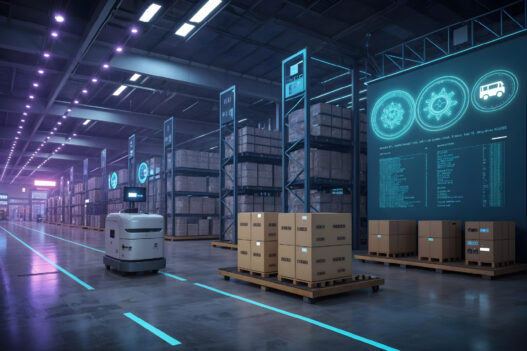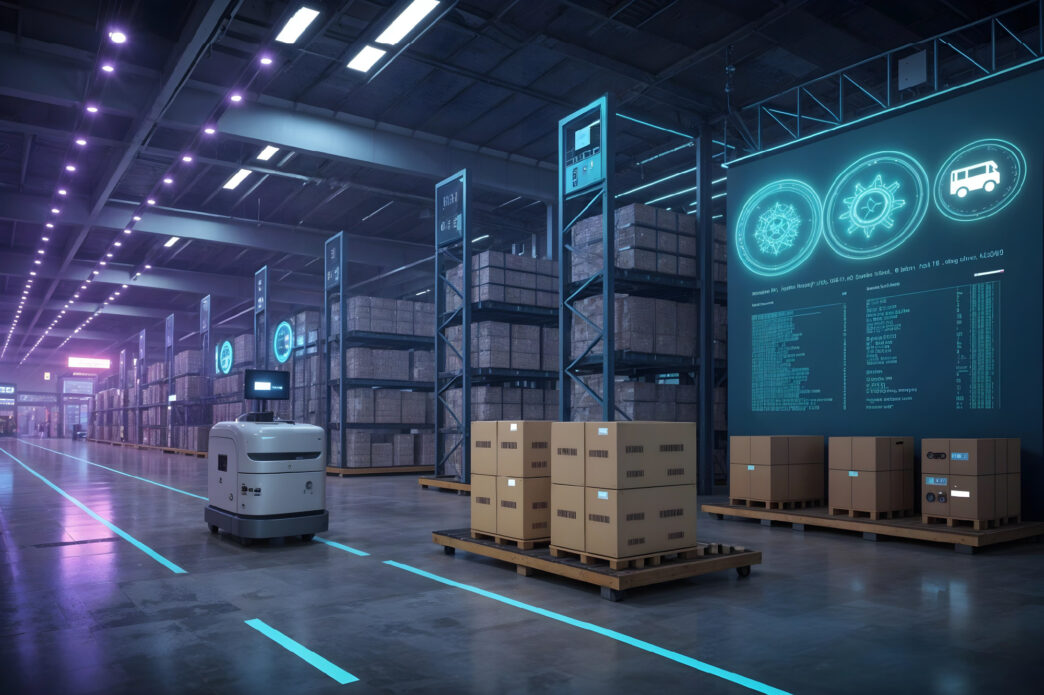Introduction
Smart warehousing is not a buzzword for the future — it’s now the new norm in logistics. According to SNS Insider’s latest research, the Smart Warehousing Market was valued at USD 22.7 billion in 2023 and is expected to reach USD 75.7 billion by 2032, with a growing compound annual growth rate (CAGR) of 14.3% during the forecast period 2023-2032. For SMBs eager to grow/ scale efficiently or a 3PL (Third-party Logistics) that wants to streamline their fulfillment operations, this transition toward automation, real-time data, and intelligent systems is non-negotiable in today’s modern warehousing world.
If you’re wondering what smart warehousing means and why it’s becoming essential, then you’re at the right place. Let’s break it down in simple terms and explore how this technology-driven revolution can transform your warehouse operations and benefit your business.
What Is a Smart Warehouse?
Smart warehouses leverage both advanced technologies and automation to optimize warehouse operations and to develop a connected, automated, and data-driven environment. Consider it as a modern-day assistant, a highly efficient, technologically advanced version that has intelligent tools and features installed to monitor, analyze, and control every move we make on the inside. It’s about connecting physical infrastructure with digital intelligence to optimize every aspect of warehouse operations, from receiving and storage to order processing and shipping.
The smart warehouse uses cutting-edge technologies such as WMS, IoT sensors, and AI to streamline warehouse operations, minimize errors, and increase productivity. Smart Warehouse can dramatically improve the functionality of the platform for businesses using software like Fulfillor WMS by offering real-time inventory tracking, insightful insights, seamless integrations, and lots more.
What is Smart Warehousing and How Does it Work?
Smart warehousing is no longer just about storing goods. It’s a tech-driven warehouse that leverages technologies such as IoT, AI, robotics, and cloud-based WMS to execute everyday warehouse tasks seamlessly. While traditional warehouses stay behind, a smart warehouse employs more digital tools, allowing faster, smarter, and more efficient warehousing by automating time-consuming and repetitive tasks and making data-driven decisions.
By effectively integrating hardware and software solutions, smart warehousing automates, optimizes, and streamlines end-to-end warehouse activities. Here’s how it works:
- Inbound logistics: IoT sensors and automated systems scan and log incoming inventory directly into a cloud-based warehouse management system (WMS) to eliminate manual errors and provide instant visibility to all stakeholders.
- Storage Optimization: AI and IoT devices evaluate the most optimal storage locations according to the demand and turnover of the product, keeping high-demand items near dispatch zones to facilitate fast picking.
- Order fulfillment: These robots and automated guided vehicles (AGVs) help speed up the pick, pack, and print-and-label processes of that order, increasing accuracy and reducing errors to less than 1%.
- Real-Time Updates: With dashboards, you can view real-time data on your inventory levels, order status, and warehouse performance, allowing for more informed decisions.
- Outbound Logistics: Secure, transparent delivery processes, building customer trust using blockchain and tracking technologies.
Why Does It Matter for SMBs and 3PLs?
SMBs (Small and Medium Businesses) are often overwhelmed by the number of sales channels they manage across their inventory. SMB warehouse solutions, like smart warehousing, cut down the complexities by digitalising the simple tasks and yielding real-time insights. Additionally, allows you to scale your operations without the need for a large workforce or extensive manual processes.
3PLs, or third-party logistics companies that manage logistics for several customers, need smart warehousing to meet the increasing demands for quicker delivery and greater transparency. As customers demand two-day shipping and real-time tracking, smart warehouses enable 3PLs to enhance warehouse efficiency and lower labor costs.
Smart 3PL WMS solutions allow 3PLs and e-commerce brands equipped with a cloud-based WMS and smart warehousing technology to operate smoothly across regional as well as global borders.
Key Technologies Driving Smart Warehousing
Let’s deep dive into the elements that make a warehouse smart:
1. IoT in Warehousing:
Smart sensors, RFID tags, and GPS trackers are some IoT devices that play a central role in real-time data collection on inventory, equipment, and environmental conditions throughout the warehouse. Integrating IoT in warehousing is like giving your warehouse a pair of digital ears and eyes.
2. Warehouse Automation:
This includes automated storage and retrieval systems (AS/RS), conveyor belts, sorting machines, and more. Imagine a warehouse where robots pick items and humans work on handling exceptions — that is the synergy automation professes.
3. AI in Warehousing:
AI algorithms forecast demand, streamline space, and even schedule labor. You are using data-driven insights instead of random guesses. This ability to save time and information enables an SMB using AI to make better decisions, especially during peak seasons.
4. Cloud-Based WMS:
Modern WMS platforms such as FulFillor 3PL WMS provide scalable, hassle-free, cloud-based SMB warehousing solutions that can be accessed anytime, anywhere. Forget clunky on-site software. Simply log in and run your operations remotely.
5. Warehouse Robotics:
Robots do more than heavy lifting. They’re covering warehouse floors, checking inventory, restocking shelves, and making sure your fulfillment is accurate and speedy. Companies such as Amazon have already demonstrated the potential of robotics.
Benefits of Smart Warehouses
So, why should you care about smart warehousing?
1. Improved Productivity/Efficiency:
Enhanced workflows or automation result in speedier processing cycles with lower rates of congestion and improved throughput. Minimizing energy use also means improved efficiency.
2. Reduced Operational Costs:
Automation lowers the cost of labor, while optimized inventory management helps to reduce carrying costs and waste, giving you more capital to put towards growth.
3. Better Accuracy/ Reduced Errors:
No more stockouts and erroneous orders. With automation, manual errors in inventory and order fulfillment are reduced by as much as 60%, minimizing costly mistakes, which entails an increase in order accuracy along with customer satisfaction.
4. Faster/Quicker Turnaround Times:
Automated picking and optimized storage reduce delivery lead times, with companies like Amazon eliminating 70% of its time for delivery thanks to its investment in smart warehousing.
5. Scalability and Flexibility:
Expand without the headaches. The smart warehouse technologies allow businesses to adjust more seamlessly to changes in demand and scale their businesses up or down without a hitch.
6. Improved Customer Satisfaction:
Fast & accurate delivery = Happy Customers = Repeat Business. Faster and reliable shipment increases customer satisfaction and loyalty.
7. Improved Space Efficiency:
Optimized layouts and smart storage solutions ensure that every inch of warehouse space is utilized effectively.
8. Improved Visibility & Traceability:
Cloud-based WMS will keep you updated all the time about shipment status, inventory levels, etc. Tracking goods in real-time enables end-to-end visibility across the supply chain.
Key Strategies to Operate a Successful Smart Warehouse
1. Build a Robust Digital Infrastructure.
Choose a cloud WMS that integrates with your existing tools. Start automation with order and inventory management—don’t attempt to automate everything at once.
2. Invest in training and change management:
The smartest tech needs people behind it. Invest in your team’s skills so they’re able to both use automation tools and look for data insights. Investing in training programs will ensure that your company knows how to utilize these tools correctly so that you get the most out of ROI while simultaneously experiencing minimal disruption.
3. Work with tech-enabled 3PLs:
Partnering with 3PL providers that utilize state-of-the-art smart warehousing will allow SMBs to tap into the latest technologies without the burden of upfront costs. This partnership again leverages fulfillment networks for faster shipping.
Final Thoughts
We are in an age where the power of technology can turn even the outdated warehouses into a smart, productive powerhouse. Smart Warehousing is not just a trend, but a vision for building the future of logistics operations. As consumer expectations increase and the logistics landscape evolves, SMBs and 3PLs require intelligent and responsive systems to stay competitive. Be it operating a single warehouse or engaging with multi-channel fulfillment irrespective of the region, advancements like AI, IoT, and cloud-based WMS are the key to operational excellence.
And if you’re wondering where to begin, platforms such as Fulfillor demonstrate how possible smart warehousing is. It’s time to stop their logistics challenges and start solving them proactively. The future arrives, and it’s smart.
About Author: Visvendra Singh Rajpoot is a logistics tech enthusiast and CEO of NOI Technologies LLC and FulFillor, having 9+ years of experience in warehouse management solutions, helping SMBs and 3PL businesses in achieving sustainable smart warehousing for long-term growth.












